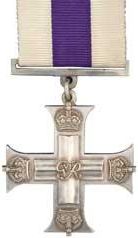Battlefield Cross
also called the Soldier's Cross

The cross in the battlefield symbolises a fallen soldier. And like the cross, which is now recognised as a Christian symbol, the contemporary Battlefield Cross originates from an ancient Pagan custom.
Crosses associated with men-at-arms are found on various banners and medals, often in the form of the Maltese Cross or Military Cross. This page, however, looks at a particularly unusual and infamous symbol known variously as the Battlefield Cross, Battle Cross, Soldier's Cross or Fallen Soldier's Cross.
A rifle pointing downwards into the ground is a memorial of a soldier killed in action. Often the rifle is capped by a helmet and perhaps dog tags, and at the bottom, a pair of boots to represent the final march of the last battle - items the soldier has no further need for.
Sometimes the rifle pierces the ground with a fixed bayonet, defiantly symbolising that the soldier went down fighting. The rifle may be stabbed into a grave-like mound of earth or mounted, as with our illustration, on sandbags giving an image more like Christ's Cross on Calvary. This reminds us that the soldier, willingly or unwillingly, sacrificed his life for his country.
Thrusting a weapon into the ground is not a new idea - warriors have been doing that for thousands of years to symbolise the fight is over. (See also Crusader's Sword)
The final killing of the dragon by St. George is depicted with the spear pointing down into the dying beast. The battle is won, the fight is over. The Battlefield Cross as a grave marker says the soldier's fighting days are over.
Of course, spears and rifles are weapons, not crosses. The so-called Battlefield Cross is not a cross and not even used to mark an actual grave - it would be foolish to leave a weapon unattended. Rather, the inverted rifle is a simple memorial in honour of the soldier's ultimate sacrifice. Its makeshift appearance says there is not enough time in battle to prepare a nicely polished marble tombstone or cenotaph.

The inverted rifle contrasts with an upward pointing weapon (see the Spear and Cross and Crossed Swords) in its ready-for-action mode. (Weapons carried by police and security forces may point downwards; a less aggressive and less provocative position.)
Burying corpses with their weapons goes back thousands of years. Hunters would be buried with their spears enabling them, according to their ancient religion, to look after themselves in their next life. After the collapse of Roman rule in Western Europe in around AD 400, Pagan tribes buried their men with swords, knives and spears.
In March 1963, the US Military Assistance Command (M A C V) issued a badge to 12,000 "advisors" in Vietnam. The badge used the red and yellow of the Vietnam flag; the yellow fashioned as crenels to represent the Great Wall of China and the red representing aggression pouring through that wall, i.e. Communism. The white sword, representing the US military, points upward in reference to the offensive action in repelling Communism.
Millions died.
The Vietnam Veterans Against the War (V V A W) modified this insignia for their own use, replacing the upward-pointing sword with the downward-pointing rifle. For them, the fighting in Vietnam was over.
Their current fight is on two fronts: to prevent the United States embarking on new "adventures" like the Vietnam War, and also to secure a decent way of life for military veterans and their families.
On Omaha Beach at the height of the battle for Normandy in WWII, Allied engineers were tasked with digging shallow graves for fallen comrades. Medics then carried dead soldiers to this makeshift graveyard for a temporary burial; and to mark the grave, the soldier's rifle was stuck into the ground. With the corpses removed from the battlefield, there was less of a reminder of the death awaiting the incoming waves of reinforcements.
The rifle was used mainly as a marker, rather than any profound meaning it might represent; and yet it is interesting that a Pagan practice of pointing weapons downward is copied by soldiers of a nominally Christian culture. Unlike the ancient Pagans, Christians believe that weapons are not needed in the afterlife - ineffective against the horror of Hell and totally obsolete in the glory of Heaven. (See also Pagan symbols copied into Christianity.)
"Soldier, rest! Thy warfare o'er,
Sleep the sleep that knows not breaking,
Dream of battled fields no more.
Days of danger, nights of waking."
(from 'The Lady of the Lake'
by Sir Walter Scott)
See also Veteran's Cross, Funeral Cross and Wreath
Jesus, on the other hand, willingly sacrificed his life for the whole of mankind
Sometimes a rifle might be used to mark a temporary grave, in an area where the unattended weapon is considered unlikely to be a danger
These men were not necessarily soldiers - more likely it was their higher social status that empowered them to bear arms






